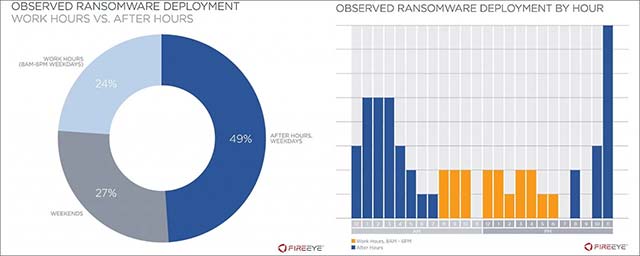Research: The golden time to prevent malicious code after the system is compromised
Recently, ransomware-spreading malicious agents have also started deploying tactics to collect and exploit victims' data, then use them as leverage to force them to pay ransom with the threat of information leakage. The information is stolen, making the recovery much more difficult. However, this strategy also exists loopholes.
There was enough time to establish a defense
As mentioned, ransomware miners usually deploy malicious payloads after at least 3 days, in 75% of all ransomware incidents that FireEye investigates, so this is also considered a golden time for organizations. deploying preventive measures, helping minimize the possible damage. It is even possible to prevent ransomware deployment if the organization's cybersecurity team has sufficient knowledge and level of security to deal with the same security.
In some successful containment cases, it was discovered that ransomware payloads were pushed into the victim's system, but could not be deployed as usual.
Basically to hack into a victim's network, ransomware exploiters often use some methods like RDP (in the case of LockerGoga malware), phishing emails with malicious links or attachments. (Ryuk) and download malware (Bitpaymer and DoppelPaymer) as original vectors of infection.
The moment the malware was deployed
According to information that the FireEye team pointed out, in most cases (76%) ransomware started encrypting data on victims' systems outside office hours, specifically "on weekends or before 8:00 am / 6:00 pm every weekday, "and may change flexibly according to the victim's schedule.

This tactic allows an attacker to avoid the scanning operations of the system security team, ensuring that incident response measures will not be implemented in time to prevent the attack.
In order to protect the system against ransomware attacks according to the above motif, FireEye recommends that organizations block the infection vector by implementing multi-factor authentication measures, planning a test. regular systems, and using security solutions and email systems capable of detecting common malware strains like Trickbot, Emotet and Dridex.
In addition, organizations should implement network segmentation techniques, regular backups, restrict local administrators, use unique passwords, and especially improve security knowledge. Secret of system personnel.
You should read it
- New ransomware detection not only encrypts files but also helps 'clean up' the system
- Strange ransomware detection only attacks the rich
- 7 kinds of ransomware you didn't expect
- Disable malicious HiddenTear Ransomware with HT Brute Forcer
- STOP - Ransomware is the most active in the Internet but rarely talked about
- Shade ransomware, the nightmare of 5 years ago is showing signs of returning
- Lukitus Guide to preventing extortion malicious code
- How to prevent malicious blackmail JPG code via Facebook Messenger
- Ryuk Ransomware has added 'selective' encryption capabilities.
- List of the 3 most dangerous and scary Ransomware viruses
- The official LooCipher ransomware decoder has been released, helping you to retrieve data completely free
- Discovered new ransomware on Mac computers
May be interested

Already in 2020, passwords are still the leading cause of data breaches

Warning: The number of vulnerabilities in open source software are increasing rapidly

Microsoft has just taken down a huge botnet network

AMD CPUs also have security vulnerabilities that have existed for many years now!

Found an 'unpatchable' flaw in Intel CPUs

Even Deepfake fraud detection tools can be deceived






 Warning: The new Facebook virus, a malicious code that is spreading rapidly through Messenger
Warning: The new Facebook virus, a malicious code that is spreading rapidly through Messenger 10 million Android devices are preinstalled with malicious code from the factory
10 million Android devices are preinstalled with malicious code from the factory After WannaCry, Petya's 'extortion' malicious code is raging, this is a remedy to prevent
After WannaCry, Petya's 'extortion' malicious code is raging, this is a remedy to prevent How to prevent malicious blackmail JPG code via Facebook Messenger
How to prevent malicious blackmail JPG code via Facebook Messenger How to identify WannaCry malicious code from Vietnam Computer Emergency Response Center (VNCERT)
How to identify WannaCry malicious code from Vietnam Computer Emergency Response Center (VNCERT) Find bug in Emotet malware, prevent it from spreading for 6 months
Find bug in Emotet malware, prevent it from spreading for 6 months